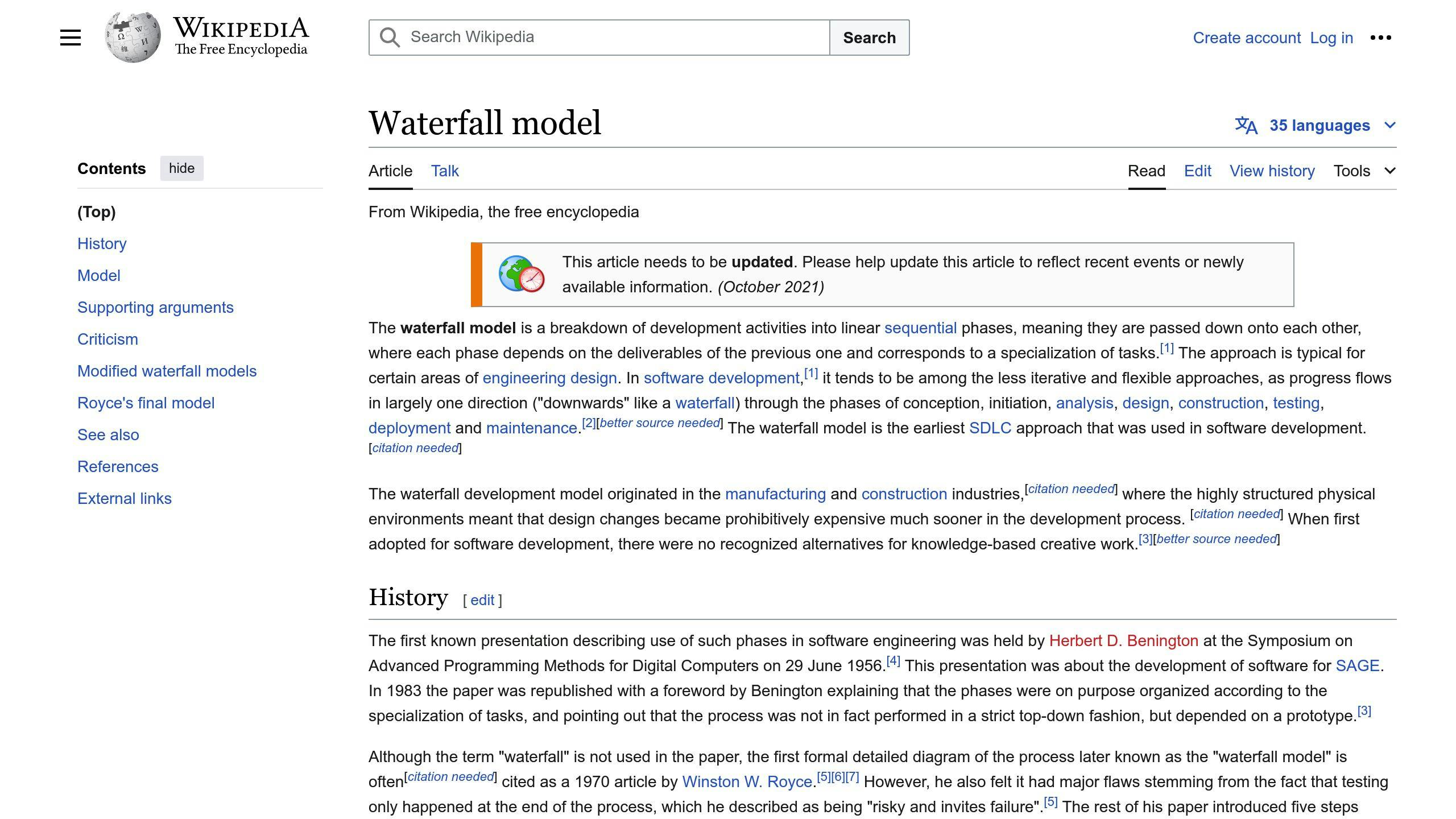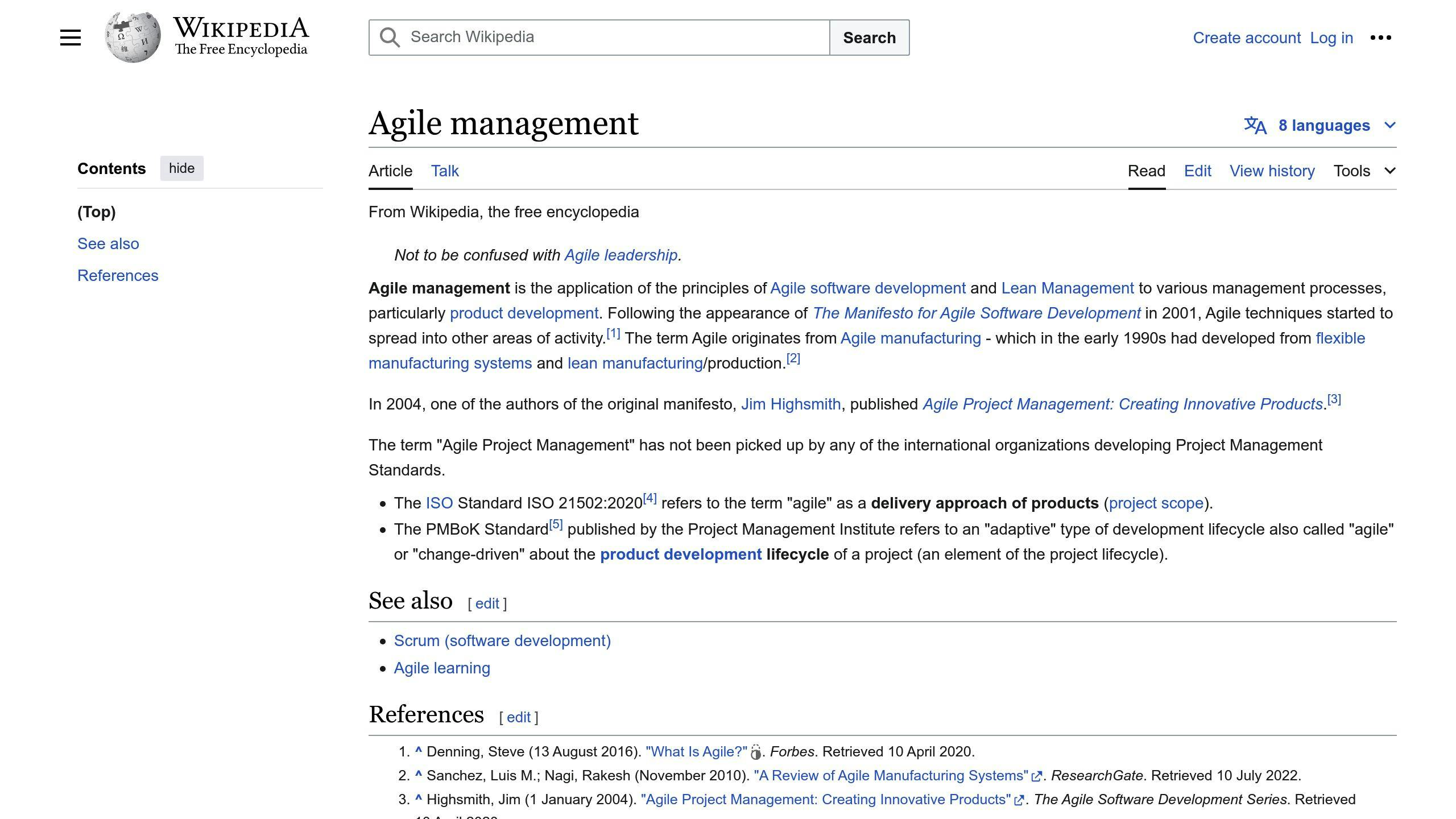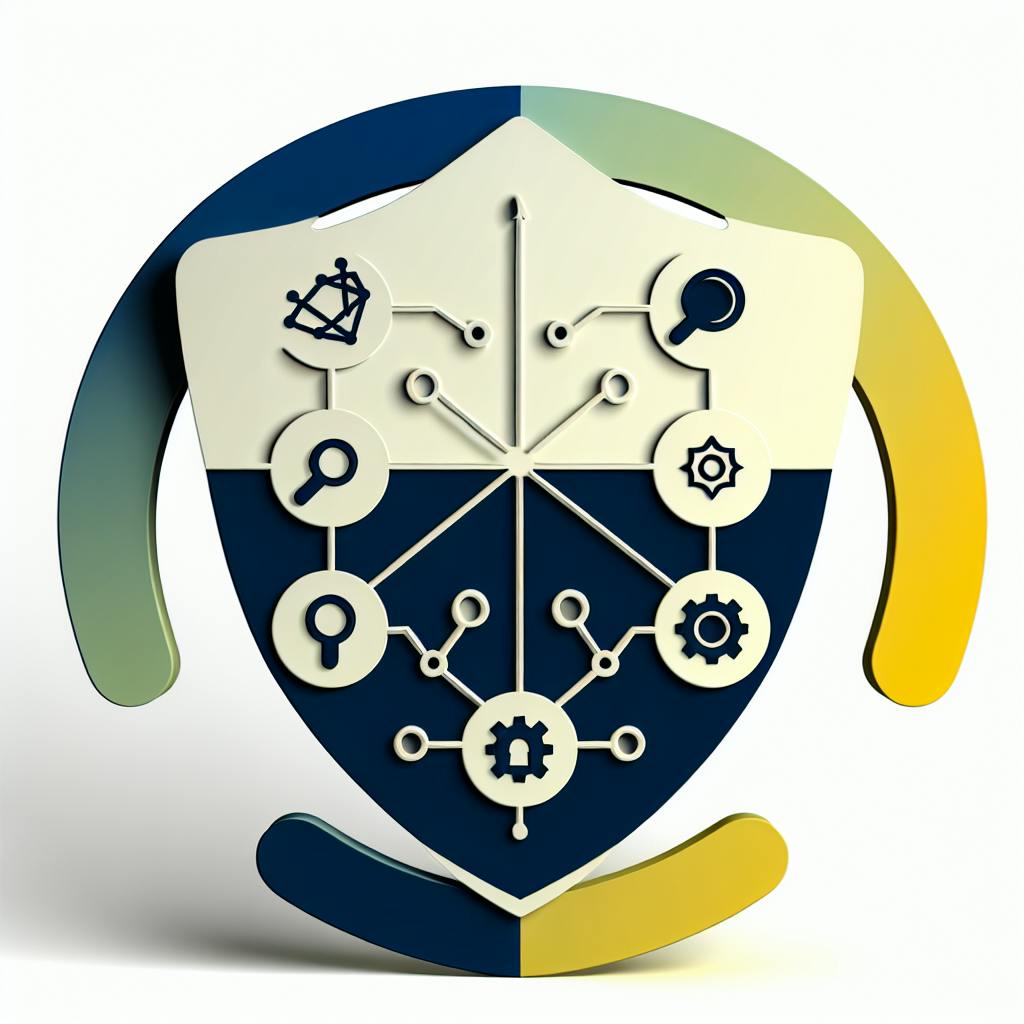Waterfall project management follows a sequential, linear approach with distinct phases. Each phase must be completed before moving to the next, making it suitable for projects with well-defined requirements and minimal changes.
Key Points:
- Linear, step-by-step process with no overlapping phases
- Emphasis on thorough upfront planning and documentation
- Works best for stable projects with clear requirements
- Provides a structured flow, defined roles, and progress tracking
- Struggles with evolving requirements and adapting to changes
When to Use Waterfall:
Use Waterfall for projects that:
- Require a structured, phased approach
- Have well-defined requirements
- Involve multiple stakeholders
- Operate in a stable environment
Prerequisites for Waterfall:
| Prerequisite | Description |
|---|---|
| Well-Defined Project Scope | Clearly outline goals, deliverables, and timelines |
| Stable Environment | Minimal anticipated changes in requirements or resources |
| Experienced Team | Team with established processes and necessary skills |
| Detailed Documentation | Document requirements, plans, test cases, and procedures |
Waterfall vs. Agile: A Quick Comparison
| Aspect | Waterfall | Agile |
|---|---|---|
| Approach | Linear, sequential | Iterative, incremental |
| Requirements | Well-defined | Evolving |
| Scope | Clear | Uncertain |
| Change Management | Difficult | Easy |
| Customer Involvement | Limited | Continuous |
Waterfall is commonly used in industries like construction, manufacturing, healthcare, and government. As project management evolves, Waterfall may adapt by combining with Agile principles and utilizing project management tools for increased efficiency.
Related video from YouTube
Waterfall Project Phases

Waterfall project management follows a step-by-step process with distinct phases. Each phase must finish before moving to the next one.
Gather Requirements
In this first phase, the team collects and documents all project needs. They identify stakeholders, get their input, and define the project's scope, goals, and deliverables. The result is a requirements document that guides the entire project.
Design Plan
The team creates a detailed project blueprint based on the requirements. This includes developing a schedule, allocating resources, and identifying risks and solutions. The output is a project plan that outlines how the project will be executed.
Build Product
The team develops the product or solution according to the design plan. This involves executing project tasks and ensuring the product meets quality standards.
Test and Verify
Rigorous testing and review ensure the product aligns with the initial requirements and design. Any defects or issues are identified and fixed.
Launch Product
The final product or service is officially delivered to stakeholders. This includes deploying the product and gathering feedback.
Maintain Product
Ongoing support and updates ensure the product's continued functionality. This involves monitoring performance, identifying improvements, and implementing changes as needed.
| Phase | Description |
|---|---|
| Gather Requirements | Collect and document project requirements, scope, goals, and deliverables. |
| Design Plan | Create a detailed project blueprint, schedule, resource allocation, and risk mitigation strategies. |
| Build Product | Develop the product or solution according to the design plan and quality standards. |
| Test and Verify | Test and review the product to ensure alignment with requirements and design, fixing any defects. |
| Launch Product | Officially deploy and deliver the final product to stakeholders, gathering feedback. |
| Maintain Product | Provide ongoing support, monitor performance, identify improvements, and implement changes. |
Prerequisites for Waterfall
Well-Defined Project Scope
A clear project scope is key for Waterfall. It outlines the project's goals, deliverables, and timelines. A defined scope prevents scope creep and keeps everyone focused on specific tasks.
Stable Environment
Waterfall requires a stable environment with minimal changes expected in requirements, resources, or timelines. A stable environment allows the team to work efficiently without interruptions.
Experienced Team
An experienced team is necessary for successful Waterfall implementation. The team should have established processes, understand project requirements, and possess the skills to execute tasks. An experienced team can identify risks and develop mitigation strategies.
Detailed Documentation
Extensive documentation is essential throughout the project lifecycle. This includes documenting requirements, design plans, test cases, and maintenance procedures. Detailed documentation ensures all stakeholders understand the project and provides a reference for future projects or audits.
| Prerequisite | Description |
|---|---|
| Well-Defined Project Scope | Clearly outline goals, deliverables, and timelines to prevent scope creep. |
| Stable Environment | Minimal anticipated changes in requirements, resources, or timelines. |
| Experienced Team | Team with established processes, understanding of requirements, and necessary skills. |
| Detailed Documentation | Document requirements, plans, test cases, and maintenance procedures. |
Waterfall vs. Agile

Different Approaches
Waterfall and Agile are two distinct project management methods with contrasting approaches:
- Waterfall: A linear, step-by-step process where each phase must finish before moving to the next. It follows a rigid plan based on predetermined requirements and scope.
- Agile: An iterative, cyclical process where the project is divided into smaller chunks. Each chunk is developed and refined in a cycle, allowing for flexibility and adaptation to changes.
Project Suitability
The choice between Waterfall and Agile depends on the project's characteristics:
| Project Characteristics | Waterfall | Agile |
|---|---|---|
| Requirements | Well-defined | Evolving |
| Environment | Stable | Dynamic |
| Scope | Clear | Uncertain |
| Complexity | Low-Moderate | High |
| Uncertainty | Low | High |
- Waterfall suits projects with well-defined requirements, a stable environment, and a clear scope.
- Agile suits projects with evolving requirements, a dynamic environment, and a high level of uncertainty or complexity.
Key Differences
| Methodology | Waterfall | Agile |
|---|---|---|
| Approach | Linear, sequential | Iterative, incremental |
| Planning | Rigid plan | Flexible plan |
| Requirements | Well-defined | Evolving |
| Scope | Clear | Uncertain |
| Team Structure | Hierarchical | Cross-functional |
| Communication | Formal | Informal |
| Feedback | Limited | Continuous |
| Change Management | Difficult | Easy |
- Waterfall follows a linear, sequential approach with a rigid plan, well-defined requirements, and a clear scope. It has a hierarchical team structure, formal communication, limited feedback, and difficulty in managing changes.
- Agile follows an iterative, incremental approach with a flexible plan, evolving requirements, and an uncertain scope. It has a cross-functional team structure, informal communication, continuous feedback, and ease in managing changes.
The choice between Waterfall and Agile depends on the specific project requirements and context. This table provides a general comparison to help understand the key differences between the two methodologies.
Waterfall Advantages
The Waterfall method offers several benefits that make it a popular choice for project management. Here, we'll explore the strengths of using Waterfall and provide a comparison table to highlight its advantages.
Clear Structure
One of the main advantages of Waterfall is its clear, step-by-step structure. This linear approach ensures that each phase is completed before moving to the next, reducing confusion and miscommunication. With a defined sequence, team members can focus on their tasks without worrying about overlapping work.
Thorough Planning
Waterfall emphasizes upfront planning and documentation. By defining requirements and scope early on, teams can identify potential issues and develop strategies to address them. This approach ensures that all stakeholders understand the project, reducing the risk of scope creep.
Defined Roles
Waterfall's hierarchical structure ensures that each team member has a clear understanding of their roles and responsibilities. This clarity prevents confusion and overlapping work, allowing team members to focus on their specific tasks.
Progress Tracking
The Waterfall method facilitates progress tracking by breaking down the project into distinct phases. This structure enables project managers to monitor progress, identify potential delays, and take corrective action to keep the project on schedule.
Comparison Table
| Advantage | Waterfall | Agile |
|---|---|---|
| Clear Structure | ✅ | ❌ |
| Thorough Planning | ✅ | ❌ |
| Defined Roles | ✅ | ❌ |
| Progress Tracking | ✅ | ❌ |
| Flexibility | ❌ | ✅ |
| Customer Involvement | ❌ | ✅ |
Note: ✅ indicates the methodology supports the advantage, while ❌ indicates it does not.
sbb-itb-d1a6c90
Drawbacks of Waterfall Project Management
While Waterfall project management offers a structured approach, it has several limitations that can hinder its effectiveness in certain projects:
Difficulty Adapting to Changes
One major drawback is the difficulty in adapting to changes. Since each phase must be completed before moving to the next, making changes to the project scope or requirements can be challenging and costly. This rigid structure can lead to delays and increased expenses if changes are necessary during the project lifecycle.
Late Feedback and Testing
Waterfall's linear approach means that feedback and testing are delayed until the later phases of the project. This can lead to issues being discovered late, making it difficult and expensive to rectify them.
Rework and Increased Costs
If changes are required, Waterfall's structured approach can result in significant rework. Since each phase builds upon the previous one, making changes can necessitate redoing portions of the project, leading to increased costs and delays.
Unsuitable for Evolving Requirements
Waterfall is not well-suited for projects with evolving or uncertain requirements. Its structured approach assumes that all requirements are known upfront, which can lead to difficulties if the project scope changes during development.
| Disadvantage | Waterfall | Agile |
|---|---|---|
| Difficulty Adapting to Changes | ❌ | ✅ |
| Late Feedback and Testing | ❌ | ✅ |
| Rework and Increased Costs | ❌ | ✅ |
| Unsuitable for Evolving Requirements | ❌ | ✅ |
| Flexibility | ❌ | ✅ |
| Customer Involvement | ❌ | ✅ |
Note: ✅ indicates the methodology supports the advantage, while ❌ indicates it does not.
Waterfall Best Practices
Gather Clear Requirements
Collect detailed project requirements from stakeholders. Ensure everyone understands the project scope, goals, and deliverables. Involve stakeholders in this process to prevent misunderstandings and meet their needs.
Develop a Detailed Plan
Create a comprehensive project plan, including timelines, milestones, and resource allocation. Maintain thorough documentation for transparency and accountability throughout the project.
Foster Open Communication
Encourage open and transparent communication within the team. Schedule regular meetings and allow feedback to identify and address potential issues early.
Conduct Rigorous Testing
Perform thorough testing and quality assurance at every stage. Identify and fix defects early to prevent costly rework and delays.
Monitor Progress Continuously
Regularly monitor project progress, identify potential roadblocks, and take corrective action to keep the project on track. Review and update the project plan to reflect changes and ensure successful delivery.
Best Practices Summary
| Practice | Description |
|---|---|
| Gather Clear Requirements | Collect detailed requirements from stakeholders to understand project scope, goals, and deliverables. |
| Develop a Detailed Plan | Create a comprehensive project plan with timelines, milestones, and resource allocation. Maintain thorough documentation. |
| Foster Open Communication | Encourage open and transparent communication within the team. Schedule regular meetings and allow feedback. |
| Conduct Rigorous Testing | Perform thorough testing and quality assurance at every stage. Identify and fix defects early. |
| Monitor Progress Continuously | Regularly monitor project progress, identify potential roadblocks, and take corrective action. Review and update the project plan. |
Waterfall Tools and Techniques
Waterfall project management uses various tools and techniques to plan, execute, and monitor projects effectively.
Project Management Tools
Project management tools help create structured plans, track progress, and deliver projects. Popular tools include:
- Microsoft Project
- Smartsheet
- Wrike
- Monday.com
- Asana
These tools offer features like Gantt charts, task dependencies, and resource allocation. For example, Wrike's interactive Gantt chart visualizes plans and progress, while Smartsheet's templates enable structured Waterfall project plans.
Work Breakdown Structure (WBS)
A WBS breaks down a project into smaller, manageable tasks. This technique helps:
- Identify tasks
- Allocate resources
- Ensure all tasks are completed on time
A well-structured WBS makes it easier to track progress and identify potential roadblocks.
Risk and Issue Tracking
Project managers must identify, monitor, and mitigate risks and issues that could impact project delivery. This involves:
- Creating a risk management plan
- Identifying potential risks
- Developing mitigation strategies
- Regular risk assessments and issue tracking
This helps project managers stay on top of potential problems and keep the project on track.
Change Control
Change control manages and documents changes within the project. It involves:
- Assessing the impact of changes
- Obtaining approval
- Implementing changes in a controlled manner
Effective change control ensures changes do not disrupt the project schedule or budget and keeps stakeholders informed.
Quality Assurance
Quality assurance ensures the project meets required standards. It involves:
| Activity | Description |
|---|---|
| Developing a quality assurance plan | Defining quality standards and processes |
| Conducting regular quality checks | Verifying adherence to standards |
| Identifying areas for improvement | Continuously enhancing quality |
Waterfall in Industries
Waterfall project management is widely used across various industries due to its structured approach and ability to handle complex projects with multiple stakeholders.
Construction and Engineering
In construction and engineering projects, Waterfall is useful due to its sequential nature. Each project phase, from planning to execution, depends on the previous phase. Waterfall ensures all stakeholders are aligned, and the project is completed on schedule and within budget. For example, in construction, the design phase must finish before the building phase can begin.
Manufacturing and Products
Manufacturing and product development projects often involve a linear process, making Waterfall suitable. The methodology helps ensure each phase, from design to production, is completed before moving to the next. This structured approach minimizes errors and ensures the final product meets specifications.
Healthcare and Pharma
In healthcare and pharmaceuticals, Waterfall manages complex projects with multiple stakeholders and regulatory requirements. The methodology ensures all phases, from research to clinical trials, are completed sequentially, minimizing errors and ensuring regulatory compliance.
Government and Public Sector
Government and public sector projects often involve multiple stakeholders and complex requirements, making Waterfall suitable. The methodology ensures all phases, from planning to execution, are completed in a structured manner, minimizing errors and ensuring timely and budget-friendly project completion.
In each industry, Waterfall provides a structured approach to managing complex projects, ensuring stakeholder alignment and timely, budget-friendly completion.
| Industry | Waterfall Benefits |
|---|---|
| Construction and Engineering | - Sequential phases ensure proper order - Aligns stakeholders - Meets schedules and budgets |
| Manufacturing and Products | - Linear process for product development - Minimizes errors - Ensures final product meets specifications |
| Healthcare and Pharma | - Manages complex projects with regulations - Sequential phases minimize errors - Ensures regulatory compliance |
| Government and Public Sector | - Structured approach for complex requirements - Minimizes errors - Timely and budget-friendly completion |
Conclusion
Key Points
- Waterfall project management follows a step-by-step approach with distinct phases.
- It works best for projects with clear requirements, stable conditions, and experienced teams.
- Advantages include a structured flow, detailed planning, defined roles, and progress tracking.
- Drawbacks are inflexibility to changes, delayed feedback, potential rework, and unsuitability for evolving requirements.
When to Use Waterfall
Use Waterfall for projects that:
- Require a structured, phased approach
- Have well-defined requirements
- Involve multiple stakeholders
- Operate in a stable environment
Waterfall is commonly used in industries like construction, manufacturing, healthcare, and government.
The Future of Waterfall
As project management evolves, Waterfall may adapt by:
- Combining with Agile principles for hybrid approaches
- Utilizing project management tools and technology for efficiency
| Waterfall Suitability | Description |
|---|---|
| Ideal Projects | - Structured, phased approach - Well-defined requirements - Multiple stakeholders - Stable environment |
| Common Industries | - Construction - Manufacturing - Healthcare - Government |
| Future Trends | - Hybrid Waterfall-Agile approaches - Increased use of project management tools |
FAQs
What is needed for Waterfall project management?
The Waterfall method requires:
- Clear Project Scope: The project goals, deliverables, and timelines must be well-defined from the start.
- Stable Environment: There should be minimal changes to the project requirements during execution.
- Experienced Team: The team members should have the necessary skills and knowledge related to the project.
- Detailed Documentation: Thorough documentation of project plans, progress, and results is essential.
| Requirement | Description |
|---|---|
| Clear Project Scope | Well-defined project goals, deliverables, and timelines |
| Stable Environment | Minimal changes to requirements during execution |
| Experienced Team | Team with relevant skills and knowledge |
| Detailed Documentation | Thorough documentation of plans, progress, and results |
In the Waterfall approach, all customer requirements are gathered at the beginning. This allows for planning each phase without further customer input until the final product is complete. The key aspects are:
- Clearly defining the project scope upfront
- Ensuring a stable environment with minimal changes
- Having a skilled and knowledgeable team
- Maintaining detailed documentation throughout the project


